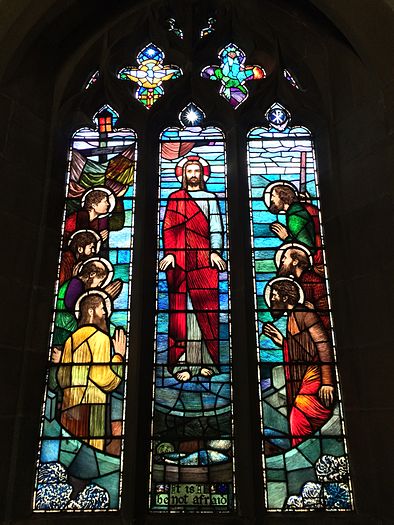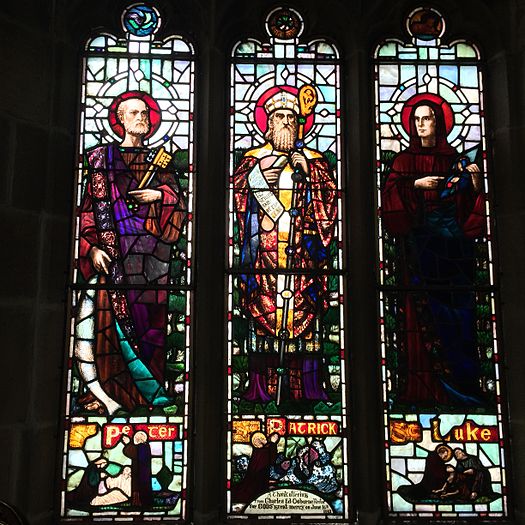
Wallsend is a town in North Tyneside, Tyne and Wear, England, at the eastern end of Hadrian's Wall. It has a population of 43,842 and lies 4 miles east of Newcastle upon Tyne.

The Church of St Margaret, Westminster Abbey is in the grounds of Westminster Abbey on Parliament Square, London, England. It is dedicated to Margaret of Antioch, and forms part of a single World Heritage Site with the Palace of Westminster and Westminster Abbey.
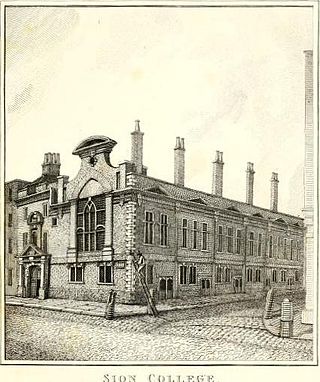
Sion College, in London, is an institution founded by royal charter in 1630 as a college, guild of parochial clergy and almshouse, under the 1623 will of Thomas White, vicar of St Dunstan's in the West.

St Martin in the Bull Ring is a Church of England parish church in the city of Birmingham, West Midlands, England. It is the original parish church of Birmingham and stands between the Bull Ring Shopping Centre and the markets.

The Parish of St. John the Baptist, the Church of Ireland Parish of Clontarf, Dublin is a religious community located on the north shore of Dublin Bay, bounded by the Parishes of North Strand to the west, Coolock to the north, and Raheny to the east.

Leeds Minster, also known as the Minster and Parish Church of Saint Peter-at-Leeds is the minster church of Leeds, West Yorkshire, England. It stands on the site of the oldest church in the city and is of architectural and liturgical significance. A church is recorded on the site as early as the 7th century, although the present structure is a Gothic Revival one, designed by Robert Dennis Chantrell and completed in 1841. It is dedicated to Saint Peter and was the Parish Church of Leeds before receiving the honorific title of "Minster" in 2012. It has been designated a Grade I listed building by Historic England.
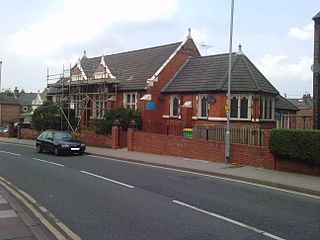
The Church of St. Thomas of Canterbury is an active Anglican parish church situated in the City of Chester, in an area of the city informally known as "The Garden Quarter", a densely populated area, close to the University. The church was built in 1872, but the parish of St. Oswald which it serves is much older, dating back to about 980 AD. One of the earliest references to St. Oswald's can be found in Bradshaw's. The parish registers date back to 1580. The church is recorded in the National Heritage List for England as a designated Grade II listed building. The church is part of the diocese of Chester, the archdeaconry of Chester and the deanery of Chester. The patrons of the parish are the dean and chapter of Chester Cathedral.
The Deanery of Cadbury represents the Church of England in mid Devon, within the Archdeaconry of Exeter and the Diocese of Exeter. The current rural dean is Matthew Tregenza.

St. Mary's Church, Broadwater, is a Church of England parish church in the Worthing Deanery of the Diocese of Chichester. It serves the ecclesiastical parish of Broadwater, West Sussex and is named after St. Mary. St Mary's is one of several sites in this benefice along with Queen Street and St. Stephen's.

Holy Trinity Church, Coventry, is a parish church of the Church of England in Coventry, West Midlands, England. Above the chancel arch is an impressive Doom wall-painting.

Joseph Ferguson Peacocke was a Church of Ireland cleric. He was the Bishop of Meath from 1894 to 1897 and then Archbishop of Dublin from 1897 until 1915. He was also briefly the professor of pastoral theology at Trinity College, Dublin.
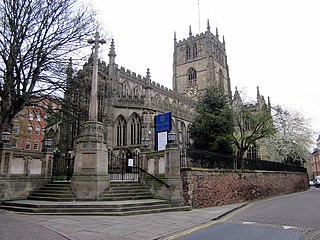
The Church of St Mary the Virgin is the oldest parish church of Nottingham, in Nottinghamshire, England. The church is Grade I listed by the Department for Digital, Culture, Media and Sport as a building of outstanding architectural or historic interest. It is one of only five Grade I listed buildings in the City of Nottingham.

The Church of Saint Luke and The Epiphany is an Episcopal congregation located at 330 South 13th Street between Spruce and Pine Streets in the Center City neighborhood of Philadelphia, Pennsylvania. It is part of the Diocese of Pennsylvania. The church was formed in 1898 as a result of the merger of St. Luke's Church (1839) and The Church of The Epiphany (1834), which consolidated at St. Luke's location.

The Church of the Epiphany was an Episcopal congregation in Philadelphia, Pennsylvania. Founded in 1834, it merged with St. Luke's Church in 1898 to form The Church of St. Luke and the Epiphany. Its 1834 Greek Revival building, designed by architect Thomas Ustick Walter and located at 1501-15 Chestnut Street, was demolished in 1902.

The Parish Church of St Luke, Chelsea, is an Anglican church, on Sydney Street, Chelsea, London SW3, just off the King's Road. Ecclesiastically it is in the Deanery of Chelsea, part of the Diocese of London. It was designed by James Savage in 1819 and is of architectural significance as one of the earliest Gothic Revival churches in London, perhaps the earliest to be a complete new construction. St Luke's is one of the first group of Commissioners' churches, having received a grant of £8,333 towards its construction with money voted by Parliament as a result of the Church Building Act of 1818. The church is recorded in the National Heritage List for England as a designated Grade I listed building. The gardens of St Luke's are Grade II listed on the Register of Historic Parks and Gardens.

St Luke's Church, Stoke Bardolph is a parish church in the Church of England in Stoke Bardolph.

St Nicholas' Church is a Grade I listed parish church in the village of Berden, Essex, England.

St Mary and St Peter's Church is a Grade I listed Church of England parish church dedicated to Saint Mary and Saint Peter in Harlaxton, Lincolnshire, England. The church is 2 miles (3 km) south-east from Grantham, and at the eastern edge of the Vale of Belvoir in South Kesteven.
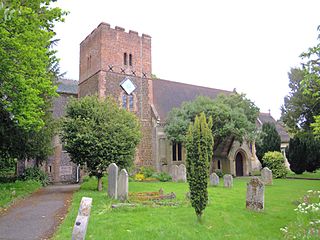
The Church of St Michael the Archangel is the parish church for the town of Aldershot in Hampshire. Dating to the 12th century with later additions, there was almost certainly an earlier church on the site. The existing structure is a Grade II listed building and is located beside Manor Park.

The Church of St Luke is a Church of England Grade II* listed church located in the centre of Wallsend, North Tyneside, next to Station Road.




